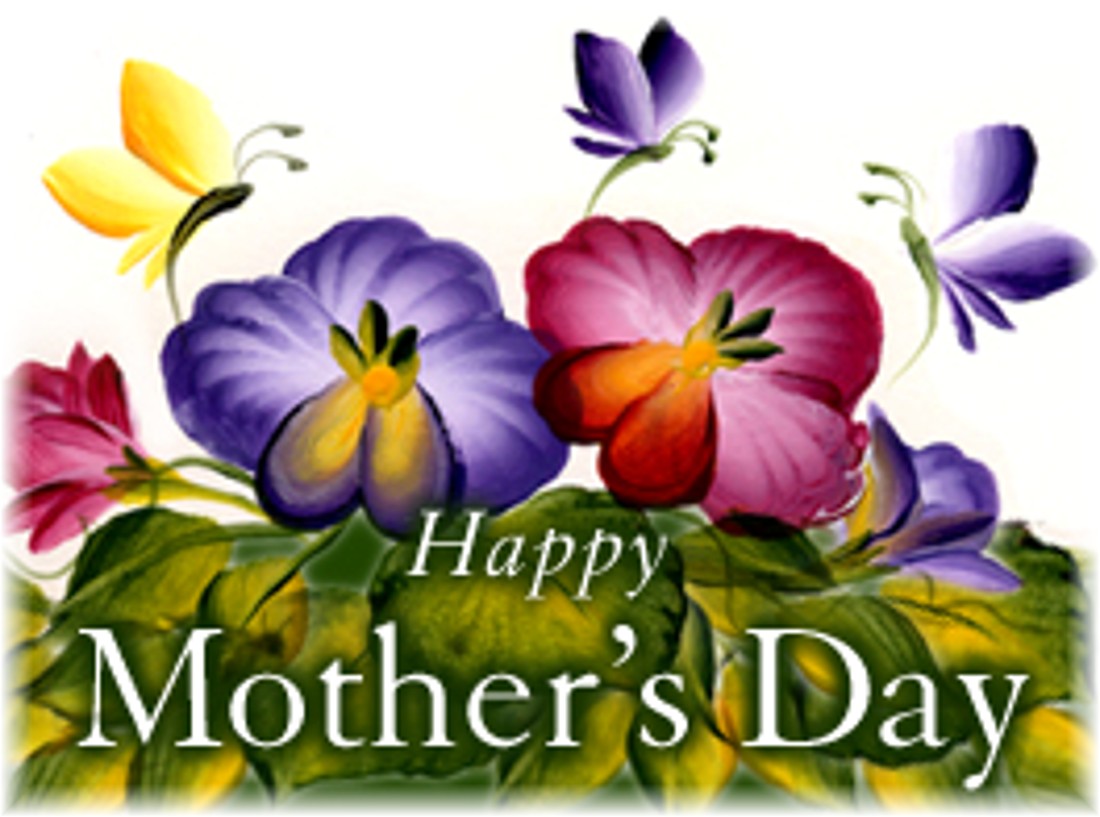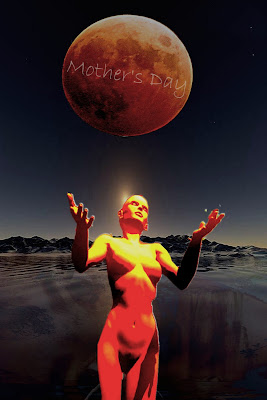|
|
A TRIBUTE TO ALL MOTHERS
4/19/2009 2:17:23 PM
|
Dearest Friends,
This is a TRIBUTE TO OUR MOTHERS!
In three weeks from today, on Sunday May 10, will be Mother’s Day…
I want to create this thread to honour each and everyone of our own Mother and, also, all the important mothers of the World that we can think of...
I Cordially Invite You and would so very much like You to transmit this Invitation to all of Your Friends in Joining us HERE in this forum to Create the Biggest Party ever…
…to Recognize and Celebrate Your Mother!

The modern Mother's Day holiday was created by Anna Jarvis as a day for each family to honor its mother,[1] and it's now celebrated on various days in many places around the world.
This holiday is relatively modern, being created at the start of the 20th century, and should not be confused with the early pagan and christian traditions honouring mothers, or with the 16th century celebration of Mothering Sunday, which is also known as Mother's Day in the UK.
In most countries the Mother's Day celebration is a recent holiday derived from the original US celebration. Exceptions are, for example, the Mothering Sunday holiday in the UK.

Historical antecedents
Different countries celebrate Mother's Day on various days of the year because the day has a number of different origins.[citation needed]
One school of thought[who?] claims this day emerged from a custom of mother worship in ancient Greece, which kept a festival to Cybele, a great mother of Greek gods. This festival was held around the Vernal Equinox around Asia Minor and eventually in Rome itself from the Ides of March (15 March) to 18 March.
The ancient Romans also had another holiday, Matronalia, that was dedicated to Juno, though mothers were usually given gifts on this day.
Spelling
In 1912, Anna Jarvis trademarked the phrases "second Sunday in May" and "Mother's Day", and created the Mother's Day International Association. [1][2]
"She was specific about the location of the apostrophe; it was to be a singular possessive, for each family to honour their mother, not a plural possessive commemorating all mothers in the world."[1]
This is also the spelling used by U.S. President Woodrow Wilson on the law making official the holiday on the U.S., by the U.S. Congress on bills,[3][4] and by other U.S. presidents on their declarations.[5]
Common usage in English language also dictates that the ostensibly singular possessive "Mother's Day" is the preferred spelling.
Dates around the world
Mother's Day is celebrated on different days throughout the world. Examining the trends in Google searches for the term "mother's day" shows two primary results, the smaller one on the fourth Sunday in Lent, from the British tradition of Mothering Sunday (it is also called ladies day and women's day), and the larger one on the second Sunday in May.[6]
The extent of the celebrations varies greatly. In some countries, it is potentially offensive to one's mother not to mark Mother's Day. In others, it is a little-known festival celebrated mainly by immigrants, or covered by the media as a taste of foreign culture (compare the celebrations of Diwali in the UK and the United States).

International history and traditions
In most countries, Mother's Day is a recent observance derived from the holiday as it has evolved in North America and Europe. Many African countries adopted the idea of one Mother's Day from the British tradition, although there are many festivals and events celebrating mothers within the many diverse cultures on the African continent that long pre-date colonisation.
Mother's Day in Japan was initially commemorated during the Shōwa period as the birthday of Empress Kōjun (mother of Emperor Akihito). Nowadays - as in the United States - the holiday is a heavily marketed concept, and people typically give flowers such as carnations and roses as gifts.

In China, Mother's Day is becoming more popular, and carnations are a very popular gift and the most sold type of flower.[12] In 1997 it was set as the day to help poor mothers, specially to remind people of the poor mothers on rural areas such as China's west.[12] In the People's Daily, the Communist Party of China's journal, an article explained that "despite originating in the United States, people in China take the holiday with no hesitance because it goes in line with the country's traditional ethics -- respect to the elderly and filial piety to parents."[12]
In recent years Communist Party of China's member Li Hanqiu began to advocate for the official adoption of Mother's Day in memory of Meng Mu, the mother of Mèng Zǐ, and formed a Non-governmental organization called Chinese Mothers' Festival Promotion Society, with the support of 100 Confuncian scholars and lecturers of ethics.[13][14] They also ask to replace the Western gift of carnations with lilies, which, on ancient times, were planted by Chinese mothers when children left home.[14] It remains an unofficial festival, except in a small number of cities.

[edit] Greece
Mother's Day in Greece corresponds to the Eastern Orthodox feast day of the Presentation of Jesus at the Temple. Since the Theotokos (The Mother of God) appears prominently in this feast as the one who brought Christ to the Temple at Jerusalem, this feast is associated with mothers.[citation needed]

Celebrated on 20 Jumada al-thani, the birthday anniversary of Fatima, Muhammad's daughter. [7] It was changed after the Iranian revolution, the reason having been theorised as trying to undercut feminist movements and promoting role models for the traditional model of family. [15][16] It was previously 25 Azar on Iranian calendar during the Shah era[citation needed]

[edit] United Kingdom and Ireland
Main article: Mothering Sunday
In the United Kingdom and Ireland, Mothering Sunday falls on the fourth Sunday of Lent, exactly three weeks before Easter Sunday (March 22 in 2009). It is believed to have originated from the 16th century Christian practice of visiting one's mother's church annually, which meant that most mothers would be reunited with their children on this day. Most historians believe that young apprentices and young women in servitude were released by their masters that weekend in order to visit their families.[17] As a result of secularisation, it is now principally used to show appreciation to one's mother, although it is still recognised in the historical sense by some churches, with attention paid to Mary the mother of Jesus Christ as well as the traditional concept 'Mother Church'.
Mothering Sunday can fall at the earliest on 1 March (in years when Easter Day falls on 22 March) and at the latest on 4 April (when Easter Day falls on 25 April).

[edit] United States / Canada
Main article: Mother's Day (North America)
North America celebrates Mother's Day on the second Sunday in May (May 10 in 2009). In the United States, Mother's Day was inspired by the British day and was imported by social activist Julia Ward Howe after the American Civil War. However, it was intended as a call to unite women against war. In 1870, she wrote the Mother's Day Proclamation as a call for peace and disarmament. Howe failed in her attempt to get formal recognition of a Mother's Day for Peace.
Her idea was influenced by Ann Jarvis, a young Appalachian homemaker who, starting in 1858, had attempted to improve sanitation through what she called Mother's Work Days. She organised women throughout the Civil War to work for better sanitary conditions for both sides, and in 1868 she began work to reconcile Union and Confederate neighbors.
Frank E. Hering, President of the Fraternal Order of Eagles, made the first known public plea for "a national day to honor our mothers" in 1904. [18][19]
When Jarvis died in 1905, her daughter, named Anna Jarvis, started the crusade to found a memorial day for women. In 1907, she passed out 500 white carnations at her mother’s church, St. Andrew’s Methodist Episcopal Church in Grafton, West Virginia—one for each mother in the congregation. The first Mother's Day service was celebrated on 10 May 1908, in the same church where the elder Ann Jarvis had taught Sunday School. Anna chose Sunday to be Mother's Day because she intended the day to be commemorated and treated as a Holy Day.
Originally the Andrew's Methodist Episcopal Church, the site of the original Mother's Day commemoration, where Anna handed out carnations, this building is now the International Mother's Day Shrine (a National Historic Landmark). From there, the custom caught on—spreading eventually to 46 states. The holiday was declared officially by some states beginning in 1912, beginning with West Virginia. On May 8, 1914, the U.S. Congress passed a law designating the second Sunday in May as Mother's Day and requesting a proclamation. [20][21] On May 9, 1914, President Woodrow Wilson made that proclamation, declaring the first national Mother's Day, [22][20] as a day for American citizens to show the flag in honor of those mothers whose sons had died in war. [20]
Carnations have come to represent Mother's Day, since they were delivered at one of its first celebrations by its founder. [22] This also started the custom of wearing a carnation on Mother's Day. [18] The founder, Anna Jarvis, delivered a single white carnation to every person, a symbol of the purity of a mother's love. [23][1][24] She chose the carnation because it was the favourite flower of her mother.[25] In part due to the shortage of white carnations, and in part due to the efforts to expand the sales of more types of flowers in Mother's Day, the florists promoted wearing a red carnation if your mother was living, and a white one if was dead; this was tirelessly promoted until it made its way into the popular observations at churches.[23][18]
In May 2008, the US House of Representatives voted twice on a resolution commemorating Mother's Day, [3][4], the first one being unanimous so that all congressmen would be on record showing support for Mother's Day.[citation needed]

[edit] Commercialization
Nine years after the first official Mother's Day, commercialization of the U.S. holiday became so rampant that Anna Jarvis herself became a major opponent of what the holiday had become and spent all her inheritance and the rest of her life fighting what she saw as an abuse of the celebration.[1]
Later commercial and other exploitations of the use of Mother's Day infuriated Anna and she made her criticisms explicitly known throughout her time.[24][1] She criticized the practice of purchasing greeting cards, which she saw as a sign of being too lazy to write a personal letter. She was arrested in 1948 for disturbing the peace while protesting against the commercialization of Mother's Day, and she finally said that she "wished she would have never started the day because it became so out of control ...".[24]
Mother's Day continues to this day to be one of the most commercially-successful U.S. occasions. According to the National Restaurant Association, Mother's Day is now the most popular day of the year to dine out at a restaurant in the United States.

|